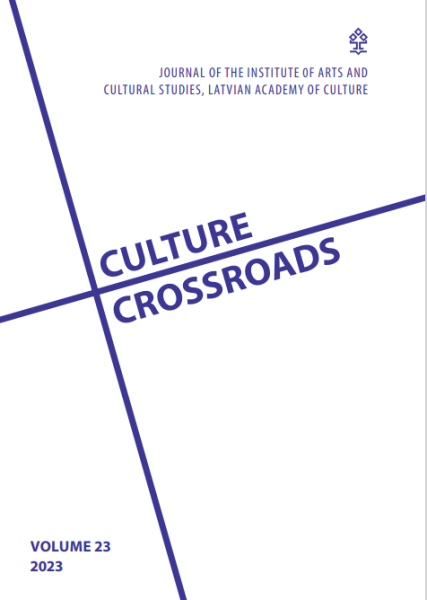ROLE OF MUSEUMS IN PROMOTING HEALTH AND WELL-BEING OF SENIORS AND DEMENTIA PATIENTS: REMINISCENCE SESSIONS
DOI:
https://doi.org/10.55877/cc.vol23.384Keywords:
Museum, Well-being, Seniors, DementiaAbstract
Museums worldwide are increasingly announcing themselves as potential partners in promoting public health and well-being. Responding to the population ageing and its consequences, seniors, including persons diagnosed with dementia, become active target audiences in museums. Reminiscence sessions are one of the most frequently used approaches in museums working with seniors and dementia patients in promoting their health and well-being. Considering the subject's topicality, the article investigates tendencies and main challenges in implementing reminiscence sessions in museum environments. The author analyses previous researches, case studies, and public programs of museums and concludes that museums, with their specific resources, suitable environments, and wide geographical spread, have an underestimated potential to become essential institutions providing reminiscence sessions. Therefore, museums should strengthen cross-sectoral cooperation networks with the health and social care sectors and implement measurable reminiscence activities for further research. In such a manner, it would promote awareness among policymakers and broader society concerning museums as credible partners for enchasing health and well-being for seniors and patients with dementia.
Downloads
References
Bansal, N., & Parle, M. (2014). Dementia: An Overview. Journal of Pharmaceutical Technology Research and Management, 2 (1), pp. 29–45. Available: DOI:10.15415/jptrm.2014.21003
Bernardo, L. D., & Reinoso Araujo de Carvalho, C. (2020). The role of cultural engagement for older adults: an integrative review of scientific literature. Revista Brasileira de Geriatria e Gerontologia, Vol. 23 (6), pp. 1–12. Available: 10.1590/1981-22562020023.190141
Burke, A., Pastorius, C., West, J. (2012). Evaluation of reminiscence activity provided to care settings by museums in Cambridgeshire. Available: https://www.sharemuseumseast.org.uk/wp-content/uploads/2018/07/Reminiscence-Study-Full-Report.pdf (viewed 17.12.2022.)
Camic, P., & Chatterjee, H. (2013). Museums and art galleries as partners for public health interventions. Perspectives in Public Health, Vol. 133 (1), pp. 66–71. Available: doi:10.1177/1757913912468523
Carolyn, T., Camic, P., Lockyer, B., etc. (2017). Museum-based programs for socially isolated older adults: Understanding what works. Health&Place, Vol. 48 (Nov.), pp. 47–55. Available: https://doi.org/10.1016/j.healthplace.2017.08.005
Cutler, D. (2019). Around the world in 80 creative ageing projects. Available: https://cdn.baringfoundation.org.uk/wp-content/uploads/BF-–-80-Creative-ageing-projects-WEB.pdf (viewed 26.01.2023.)
Eveland, L. E. (2020). Improving Health Outcomes for Senior Populations by Engaging in Museum Experiences. Master’s thesis. Cambridge: Harvard University.
Fountain, H. (2015). Top Ten Tips for Successful Reminiscence Sessions. Available: https://museumsetc.com/blogs/magazine/52341189-top-ten-tips-for-successful-reminiscence-sessions (viewed 11.12.2022.)
Gough, K. (2016). Outreach for seniors: Understanding how museum outreach can impact social well-being of seniors living in care facilities in British Columbia. Master’s thesis. Vancouver: The University of British Columbia.
Hamblin, K. (2016). Museums, Oral History, Reminiscence & Wellbeing: Establishing Collaboration and Outcomes. Available: https://www.ageing.ox.ac.uk/download/187 (viewed 17.02.2023.)
Hamblin, K., & Harper, S. (2016). The UK’s Ageing Population: Challenges and opportunities for museums and galleries. Available: https://www.ageing.ox.ac.uk/download/173 (viewed 19.12.2022.)
Heersmink, R. (2017). The narrative self, distributed memory and evocative objects. In: Philosophical Studies: An International Journal for Philosophy in the Analytic Tradition, Vol. 175 (8), pp. 1829–1849.
Jamtli, A. H. (2017). Reminiscence in open-air museum. Available: http://skanzen.hu/uploaded_files/dokumentumok/aha-project-report.pdf (viewed 28.02.2022.)
Macleod, F., Storey, L., Rushe, T., McLaughlin, K. (2021). Towards an increased understanding of reminiscence therapy for people with dementia: A narrative analysis. Dementia, Vol. 20 (4), pp. 1375–1407. Available: https://doi.org/10.1177/1471301220941275
Morse, N., & Chatterjee, H. (2017). Museums, health and wellbeing research: co-developing a new observational method for people with dementia in hospital contexts. Perspectives in Public Health, Vol. 138 (3), pp. 152–159. Available: https://doi.org/10.1177/1757913917737588
Nicholls, A., Pereira M., Sani, M. (2013). Report 2 – Heritage and the Ageing Population. The Learning Museum Network Project. Available: https://online.ibc.regione.emilia-romagna.it/I/libri/pdf/LEM2nd-report-heritage-and-the-ageing-population.pdf (viewed 24.11.2022.)
Paskaleva, D., & Tufkova, S. (2017). Social and Medical Problems of the Elderly. Journal of Gerontology & Geriatric Research, Vol. 6 (3). Available: doi:10.4172/2167-7182.1000431
Pearce, S. (2016). Reminiscence Cottage: A multisensory space for people living
with dementia. In: A. Simpson, G. Hammond (eds). A Cultural Cacophony: Museum Perspectives and Projects. Sydney: NSW of Museum Galleries Australia, pp. 222–232. Available: https://www.museumsaustralia.org.au/ma2015-sydney (viewed 25.11.2022.)
Robertson, Hamish L. (2015). Introduction. In: Hamish L. Robertson (ed). The caring museum: new models of engagement with ageing. Edinburgh: MuseumsEtc., pp. 10–27.
Silverman, L. (2009). In the service of society. In: L. Silverman (ed). The social Work of Museums. London and New York: Routledge, pp. 1–21.
Silverstein, N. M., Garcia, C., Landis, A. L. (2001). Museums and Aging: Reflections on the Aging Visitor, Volunteer, and Employee. The Journal of Museum Education: Museums and the Aging Revolution, Vol. 26 (1), pp. 3–7. Available: https://www.jstor.org/stable/40479195
Tan, M. K. B. (2018). Connecting reminiscence, art making, and cultural heritage: A pilot Art-for-Dementia care programme. Journal of Applied Arts & Health, Vol. 9 (1), pp. 25–36. Available: DOI: 10.1386/jaah.9.1.25_1
The Heritage Alliance (2020). Heritage, Health, and Wellbeing. A Heritage Alliance Report. Available: https://www.theheritagealliance.org.uk/wp-content/uploads/
/10/Heritage-Alliance-AnnualReport_2020_Online.pdf (viewed 09.11.2022.)
Thomson, L., & Chatterjee, H. (2016). Well-Being with Objects: Evaluating a Museum Object-Handling Intervention for Older Adults in Health Care Settings. Journal of Applied Gerontology, Vol. 35 (3), pp. 349–362. Available: doi:10.1177/0733464814558267
Thomson, L., Lockyer, B., Camic, P., Chaterjee, H. (2017). Effects of a museum-based social-prescription intervention on quantitative measures of psychological wellbeing in older adults. Perspectives in Public Health, Vol. 138 (1) pp. 28–38. Available: https://doi.org/10.1177/1757913917737563
Turk, A., Mahtani, K. R., Tierney, S., Shaw, L., Webster, E., Meacock, T., Roberts, N. (2020). Can gardens, libraries and museums improve wellbeing through social prescribing? Available: https://www.cebm.ox.ac.uk/resources/reports/can-gardens-libraries-and-museums-improve-wellbeing-through-social-prescribing (viewed 12.11.2022.)
United Nations (2017). World Population Ageing 2017. Available: https://www.un.org/en/development/desa/population/publications/pdf/ageing/WPA2017_Report.pdf (viewed 12.12.2022.)
Downloads
Published
Issue
Section
License
Copyright (c) 2023 Culture Crossroads

This work is licensed under a Creative Commons Attribution 4.0 International License.


